This article is part of our Rounding Third series.
We've spent a good amount of the never-ending draft season discussing stolen base strategies, but less so looking for sources of speed. Yes, the best indicator of future stolen bases probably is past stolen bases, but there have to be other indicators as well, right? The next few weeks I'll dig into those indicators, starting this week with Statcast Metrics.
Statcast Metrics
One aspect of this article I struggled with was setting the parameters for these categories. There's an inherent conflict between finding a useful statistical sample and digging deep to find a lesser owned/valued or even unowned source of speed. What I think I'll do is give last year's playing time a pretty high threshold for the overall list, but lower that number when looking at individual positions. Part of this process is not knowing what I'm going to find - will it reveal a lot of gems, or a pittance?
SPRINT SPEED
Let's start with the definition of Statcast's Sprint Speed. It's defined as "... feet per second in a player's fastest one-second window ...," pulling from two events — runs of two or more bases, and home-to-first on weakly hit grounders. There are some exceptions to each of the two events — here's a superb explanation by Mike Petriello of the Sprint Speed metric.
For the overall list, let's set the threshold at a minimum of 100 "Competitive Runs," the events listed in the definition above. We'll go with a much smaller amount per position
We've spent a good amount of the never-ending draft season discussing stolen base strategies, but less so looking for sources of speed. Yes, the best indicator of future stolen bases probably is past stolen bases, but there have to be other indicators as well, right? The next few weeks I'll dig into those indicators, starting this week with Statcast Metrics.
Statcast Metrics
One aspect of this article I struggled with was setting the parameters for these categories. There's an inherent conflict between finding a useful statistical sample and digging deep to find a lesser owned/valued or even unowned source of speed. What I think I'll do is give last year's playing time a pretty high threshold for the overall list, but lower that number when looking at individual positions. Part of this process is not knowing what I'm going to find - will it reveal a lot of gems, or a pittance?
SPRINT SPEED
Let's start with the definition of Statcast's Sprint Speed. It's defined as "... feet per second in a player's fastest one-second window ...," pulling from two events — runs of two or more bases, and home-to-first on weakly hit grounders. There are some exceptions to each of the two events — here's a superb explanation by Mike Petriello of the Sprint Speed metric.
For the overall list, let's set the threshold at a minimum of 100 "Competitive Runs," the events listed in the definition above. We'll go with a much smaller amount per position afterward — the default listed there is 10 Competitive Runs, but we'll go with 25 Competitive Runs at catcher and 50 elsewhere just to weed out the very smallest sample size. The league average across all players is 27 feet per second.
(All data here is from Baseball Savant)
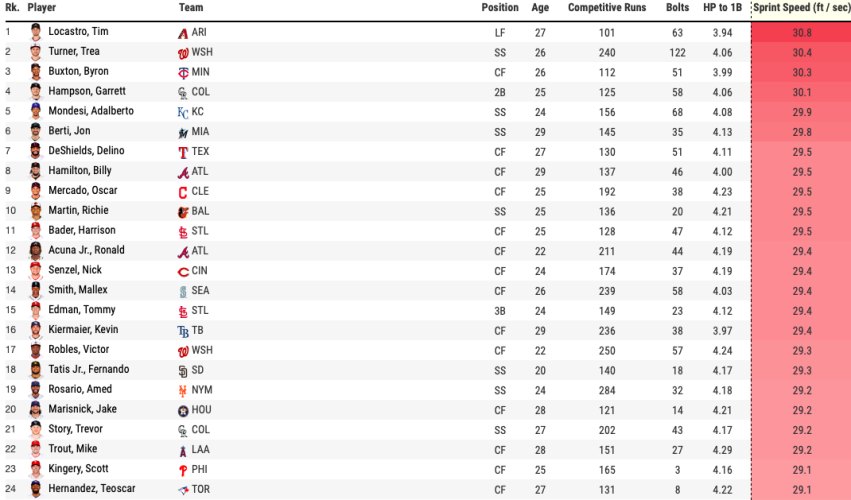
I originally set this list at the top-20 players, but expanded to 24 because I thought all four players 21-24 were interesting. Trevor Story had a combined 15 stolen bases his first two seasons, but 50 over the last two — his presence on this list demonstrates that it wasn't a fluke. Mike Trout might have run less frequently last season, but it's mostly due to his injuries, and not due to a lack of speed. Scott Kingery worked his way into regular playing time last year — if (and that's a big "if") he can get on-base more frequently, he has the potential to double last year's 15 steals. Likewise, Teoscar Hernandez has a big strikeout problem, but should he improve in that respect it would hardly shock me if he doubled last year's six stolen bases.
Otherwise, most of these names are the usual stolen base suspects. I'll highlight the two less-obvious ones in Harrison Bader and Richie Martin. I think it's pretty clear that both are fast, but neither had huge stolen base totals last year, with 11 and 10 respectively. It's also pretty clear that both struggled mightily at the plate. Bader at least is getting drafted, mostly in 15-team leagues or Draft-and-Hold formats, as the 411th player on average being drafted in the NFBC since March 1. Martin is all the way down at 725, essentially undrafted. Bader has the clearer path to playing time, as the best defensive outfielder that the Cardinals have. But he had a lousy spring, striking out 15 times in 42 plate appearances while Dylan Carlson and Lane Thomas were fantastic. But Carlson and Thomas aren't great fits in center field — the Cardinals' best defensive alternative to Bader there is Tyler O'Neill, who also scores high in Sprint Speed and went on-average one pick ahead of Bader in NFBC drafts. Meanwhile, Martin is backing up Jose Iglesias in Baltimore this year and isn't guaranteed to make the team.
As always, there are arbitrary cutoffs with these lists, but let's say that this gave us 1.5 new possibilities for speed in Hernandez and Bader. I like Hernandez's chances better, but that's no great revelation as he's going considerably sooner (average pick order — 318) than Bader.
How about the position lists? I was going to eschew catchers for this piece, but a quick look at catchers last year revealed some surprises. We all know that J.T. Realmuto has more speed than the average catcher, so his nine steals aren't surprising. But did you know that Yadier Molina was 6-for-6 in stolen base attempts, despite having the second-lowest Sprint Speed (22.8 ft/s) among qualifying catchers? Maybe that speaks more to his cleverness in trying to steal, or it suggests that he's not exactly busting it down to first base on a weak grounder — a business decision, if you will. Yasmani Grandal, Christian Vazquez, James McCann and Jorge Alfaro also all had at least four steals last year.
CATCHER

It's not a surprise that younger catchers top this list, with only one 30-year old (Austin Barnes) making the top 10. Alfaro actually had eight attempts last year but caught four times — will Don Mattingly still give him the green light next year?
FIRST BASE
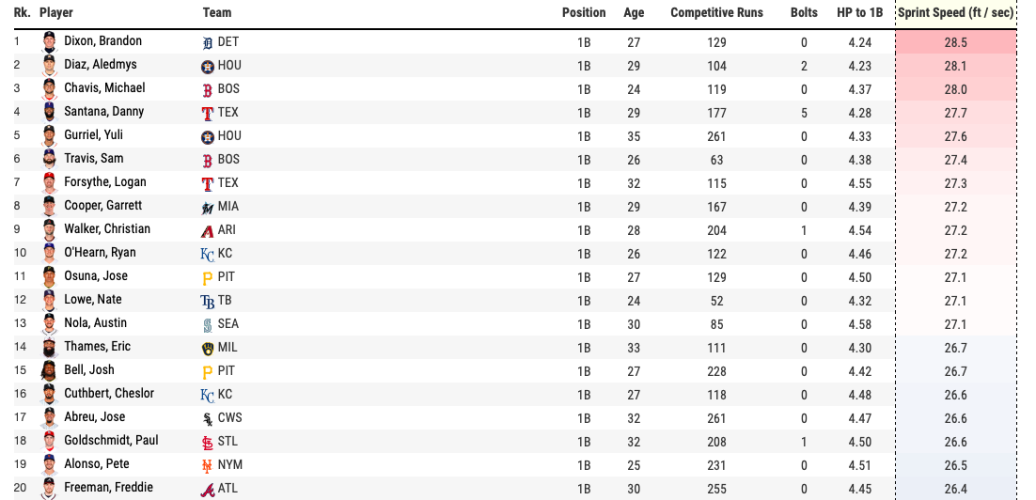
Paul Goldschmidt stole a combined 50 bases in 2016-17, but only three last season. Judging by his Sprint Speed, those stolen bases aren't coming back. It doesn't appear that steals will be part of Freddie Freeman's arsenal much longer either. I was pretty surprised to see Michael Chavis on this list, given that he had only two stolen bases last year and didn't run much in the minors either. But then again, he's agile enough to play second base, so I suppose I shouldn't be that surprised. If you owned Christian Walker last year, you probably already knew about his running ability.
SECOND BASE
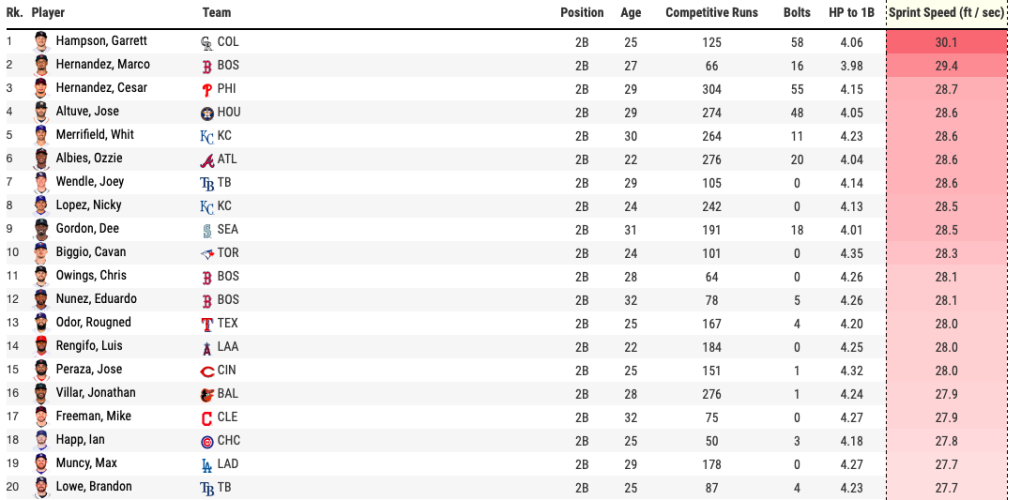
Jose Altuve stole six bases last year in 11 attempts, a sign of potential significant decline. But he also missed five weeks with a hamstring injury and had a knee injury in 2018. His sprint speed score suggests a possible dead-cat bounce, though his age and mileage could presage further injuries. Joey Wendle missed a lot of time with a wrist injury and lost ground to Brandon Lowe (who is also on this list), but his presence here reminds us he still has wheels. I didn't realize Max Muncy had above-average speed.
Second base is normally a position populated by quick players, so perhaps it's noteworthy to highlight a few players at the bottom of this positional list. Some might look to Tony Kemp to snag a few steals out of a platoon in Oakland, but his 26.4 ft/s sprint speed suggests otherwise. I thought Keston Hiura would rate higher, but he's merely average at 26.9 ft/s.
SHORTSTOP
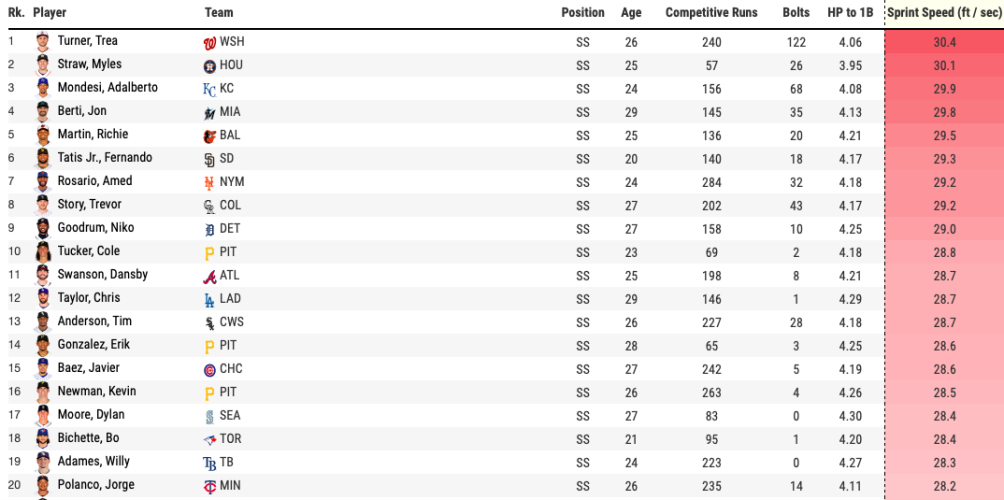
Shortstops are the fastest on the list so far. All of the top-20 are well above the major league average. That makes sense — a slow shortstop would have horrible range in the field and wouldn't last long there. Even the "below average" runners lower on this list (Andrelton Simmons, Freddy Galvis, Brandon Crawford and Johan Camargo) are barely below average, ranging between 26.3 and 25.6 ft/s. Dansby Swanson and Willy Adames both make the positive side to this list, and Swanson in particular has some potential, given how much time he missed with injuries the last two years.
THIRD BASE
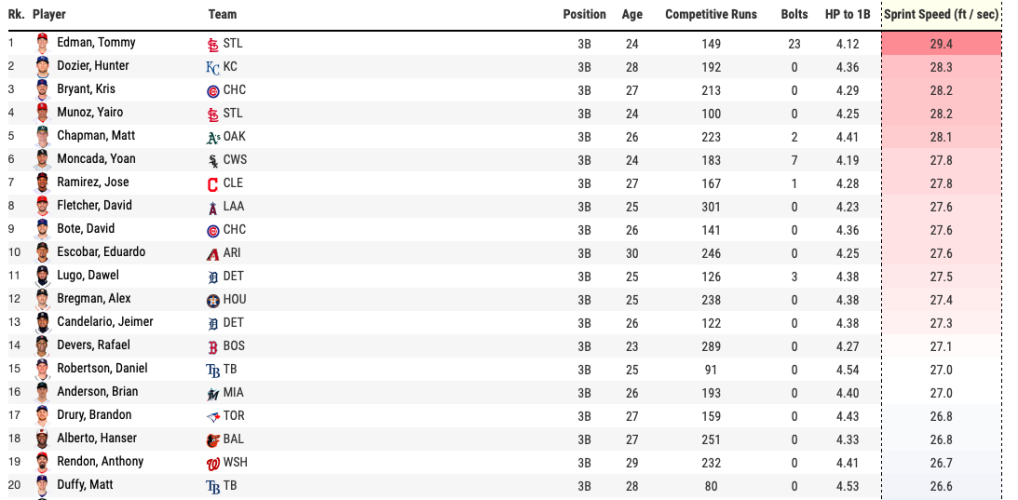
I didn't expect to see Hunter Dozier so high on the list, especially over Yoan Moncada and Jose Ramirez, who are more obvious to show up on the list. But I suppose that if a player is athletic enough to play in the outfield as well as third base, as is the case with both Dozier and Kris Bryant, it shouldn't be too surprising. Third base as a whole resembles the list of first basemen — we can't even get 20 qualifying players before starting to dip into below-average scores.
LEFT FIELD
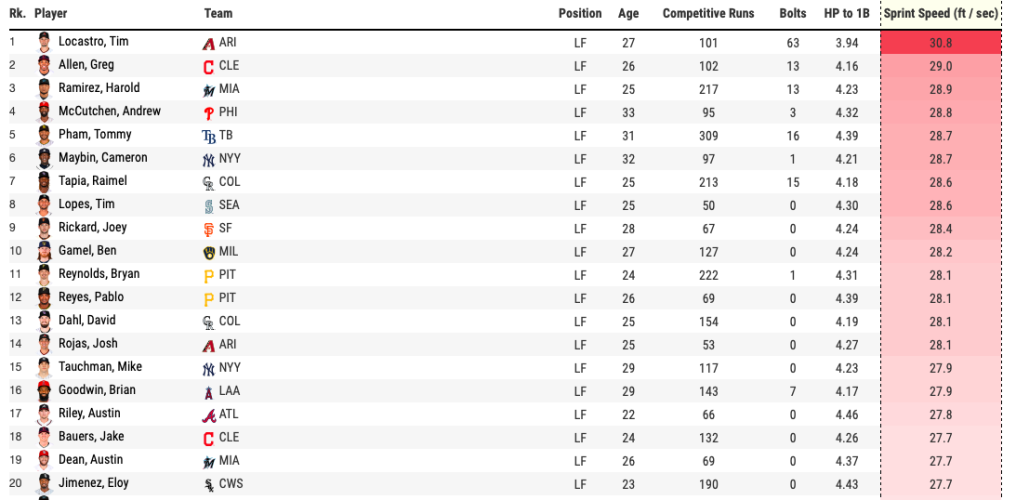
Baseball Savant breaks out the outfielders by each individual position, so we'll do the same here.
Harold Ramirez stole only two bases last year despite getting more than 400 plate appearances, but his sprint speed held up and he ran frequently in the minors. He's battling for playing time this year, but there's some hidden stolen base potential here. Josh Rojas also fits the profile, though his path to playing time is a steeper climb than Ramirez's.
CENTER FIELD
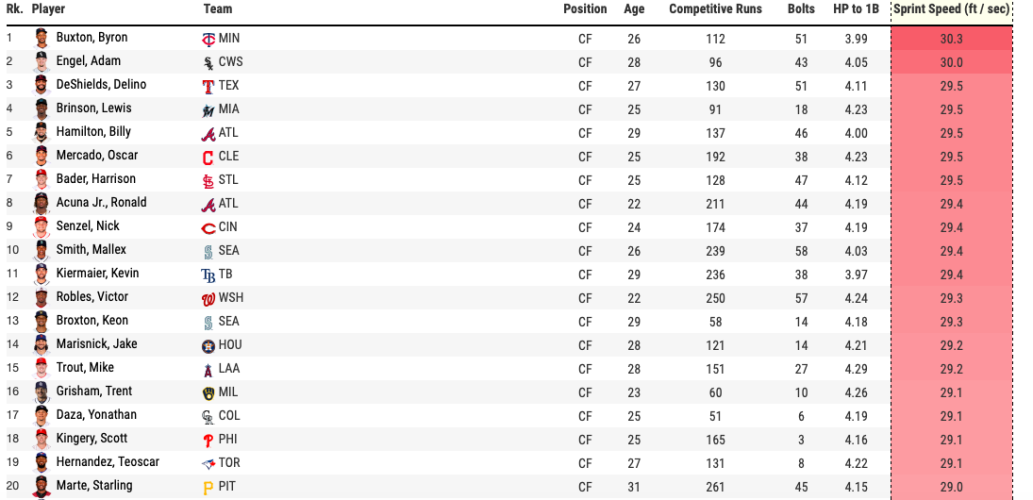
In a development surprising to nobody, center fielders as a class are even faster than the shortstops. In fact, just one qualified center fielder, the Braves' Ender Inciarte, who no longer plays CF, falls below the league average of 27 ft/s. So it follows that many of our top stolen base targets reside here, too. We mentioned Harold Ramirez earlier, so it's only fair that we highlight Lewis Brinson with the center fielders. Brinson has the high pedigree, and was generating hard contact all spring without the crippling strikeouts that had held him back. In a weird disconnect, Adam Engel is second on this list and once stole 65 bases in a minor league season, yet only had three stolen bases last year. With Luis Robert taking over, that stolen base potential is no longer relevant for Engel, but it might be worth exploring whether Robert might not have the green light from manager Rick Renteria.
RIGHT FIELD
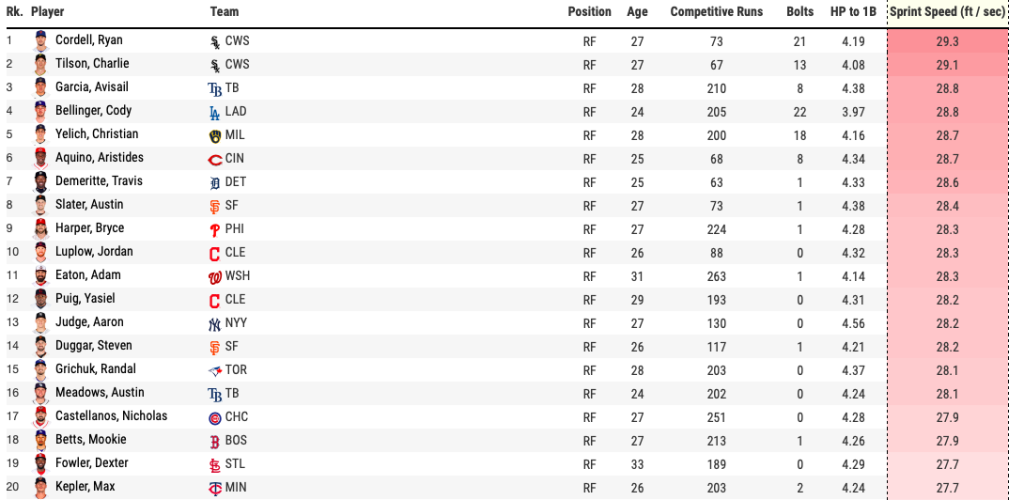
There sure are a lot of White Sox popping up on these lists. Maybe they've got a hot gun at New Comiskey Guaranteed Rate Field? Avisail Garcia can motor when healthy — it's just that he's so infrequently been fully healthy. But he did steal a career-high 10 bases last year, and the Brewers' team context certainly won't pump the brakes on him.
Meanwhile, Aristides Aquino received all of the attention he got due to his power — he is The Punisher, after all. But he also stole seven bases in 56 games last season without getting caught. The Reds were aggressive on the basepaths last season, but even with that Aquino currently isn't projected to win a starting job to begin the season. If that changes, he could be a hidden source of speed.
SLUGS
Just for fun, here are the bottom-25 overall Sprint Speed players, with a minimum 100 Competitive Runs.
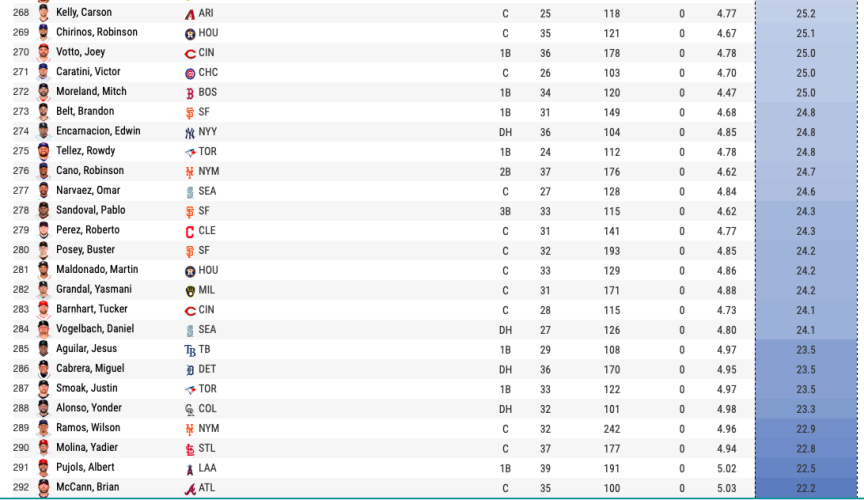
Where do we stand now with possible names? Here's the summary of those who stood out to me, to varying degrees. Your mileage may vary, and I'd encourage you to do more digging on your own.
Teoscar Hernandez
Harrison Bader
Michael Chavis
Christian Walker
Jose Altuve (as a bounce-back candidate)
Joey Wendle
Dansby Swanson
Willy Adames
Hunter Dozier
Harold Ramirez
Josh Rojas
Lewis Brinson
Avisail Garcia
I buy into some of these players more than others — Hernandez, Swanson, Brinson and Garcia probably the most.
One hesitation about using this method is that strict Sprint Speed is just one aspect of stealing bases. Before a player can get up to his peak speed on a stolen base attempt, he needs to first be able to read the pitcher, and then get off to a good jump. And then at the end of his run, he has to be proficient at sliding into the base; not just avoiding the tag, but also doing it in a way that takes the least amount of time in slowing down. I realize that these are all separate skills, so I look at Sprint Speed more as a necessary* but not sufficient indicator.
* Mostly necessary — see also, Yadier Molina's six stolen bases.
90 FEET RUNNING SPLITS
90 Feet Running Splits, if I'm parsing the data correctly, are the split times at various points as the runner is progressing from home to first. On Baseball Savant you can look up these by the Raw Split Times, or Percentile Rankings. I'll spend some more time on this factor next week — at first I thought it was something I could address in a paragraph or two, but I think merits a deeper look. But go ahead and click through now to see what you can find.
In future weeks, we'll hit on some other factors: Managerial Tendencies, Bad Teams, Batting Order, SBOs, and of course, Pitcher & Catcher Matchups. What other indicators do you think might apply?










